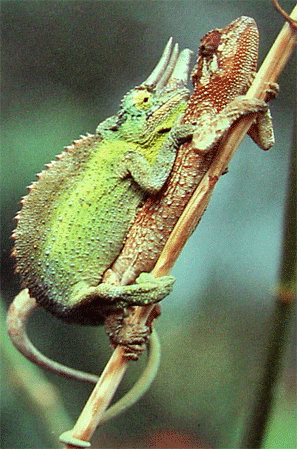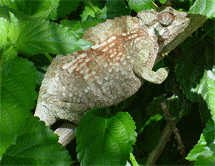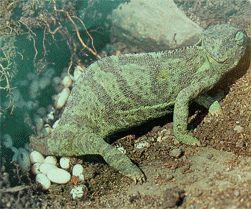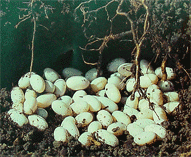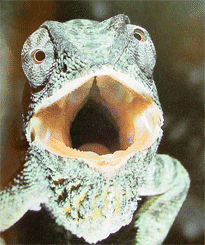 |
||
     
|
Chameleons mating Photo courtesy of 'Chameleons' by Claudia Schnieper and Max Meier |
The only time that the chameleons come together by choice is for mating; and often mating takes place between different species of chameleon. The male is always ready for mating and indicates this to the female by changing his skin colour to bright colours and inflating (puffing out) his body to show his profile whilst rocking backwards and forwards or bobbing his head. This is meant to make him look more attractive to the female. The female shows she is interested in the male by changing colour to plain green or greenish grey. If she is not interested she shows her 'stress' colours of grey with black blotching. The male moves slowly towards the female hissing and swaying his body from side to side and as the male reaches out to touch the female her colour changes to a light brown which signals that she will accept him as her mate and will not fight.
|
|
The male passes sperm into the female reproductive organs from where the embryos will begin to develop. The mating process takes about 20 minutes, and afterwards the male and female chameleons will each go their separate way. |
||
|
After mating, the female will be left on her own and warns off any other males that may attempt to come near. Gestation (the time it takes between becoming pregnant and the young being born) is between 6 - 8 months depending on the ambient temperature.
|
Pregnant female
|
|
|
Photo courtesy of 'Chameleons' by Claudia Schnieper and Max Meier
Photo courtesy of 'Chameleons' by Claudia Schnieper and Max Meier |
Most chameleons lay eggs (except the Jackson's chameleon), and the eggs are covered with soil in the ground; the mother returns up to the branches of the tree and leaves the eggs to grow and hatch by themselves.
The embryos (baby chameleons) are enclosed in a soft egg shell, and are laid in a hollow in the ground. The embryos feed from the yolk in the egg and the warmth of the soil enables them to develop. |
|
|
||
|
The young chameleons feed on small flies, spiders and any other
insects. Generally they will eat
anything up to the length of their own head. When the baby chameleons are ready to hatch they cut their shell open with a special 'egg tooth' in the front of their mouth, and then wriggle their way up to the surface through the soil, and quickly climb into the trees. Young chameleons must find food and water and their tongues are already developed for catching food - though their aim may need a little practice! |
Photo courtesy of 'Chameleons' by Claudia Schnieper and Max Meier
|
|
| Young chameleons have to look after themselves as soon as they leave their eggs. They must hide from birds, snakes and even other chameleons that will see them as food. | ||
